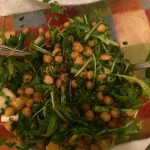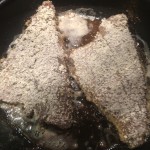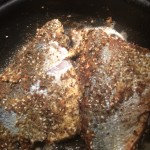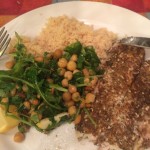This is an adaptation of a recipe I found online, having decided that Yotam Ottolenghi‘s obsession with za’atar had to be tested. This is what he says about it in his Guardian Weekend page:
Za’atar is a cornerstone of Levantine cooking. It is often paired with tahini (another Levantine essential, which I featured last week), and then spooned over vegetables, crushed pulses, grilled meat and all manner of stews. Za’atar is in many ways the smell of my childhood: the herb grows wild in the hills around Jerusalem, and has a distinctive, pungent, savoury aroma. Its scientific name, Origanum syriacum, hints at a connection to oregano, marjoram and the like, but, for me, its flavour evokes cumin, lemon, sage and mint.
Like any other plant, za’atar tastes of the soil in which it has grown, which is why Palestinian or Israeli za’atar is different from, say, Turkish or Lebanese. The first is my (ever-so-slightly biased) preference.
Za’atar leaves can be eaten fresh in salads with tomatoes, spring onions and lemon juice, or mixed through bread dough pre-baking. Outside the Middle East, though, za’atar is best known in its powdered form, for which it’s mixed with sesame seeds, sumac and salt. Confusingly, this powder is also known as za’atar. Good za’atar powder – be warned, there are lots of inferior brands out there – is made using za’atar leaves picked after they’ve gone silvery-grey, once the flowers have blossomed, and then dried and ground. Nothing should be added to them apart from the trio listed above.
The resulting green powder has a quite extraordinary ability to transform all manner of dishes: try it in today’s recipes, or keep things simple and sprinkle some on roast lamb or chicken, mix with olive oil to finish off any roast vegetable or a salad, or just scatter on hummus and fresh tomato in the simplest and most delicious sandwich I know.
The other spice I had to add was sumac, another recent addition to the supermarket shelves in this country (you shouldn’t have much trouble getting hold of either):
Sumacs are shrubs and small trees that can reach a height of 1–10 m (3.3–32.8 ft). The leaves are spirally arranged; they are usually pinnately compound, though some species have trifoliate or simple leaves. The flowersare in dense panicles or spikes 5–30 cm (2.0–11.8 in) long, each flower very small, greenish, creamy white or red, with five petals. The fruits form dense clusters of reddish drupes called sumac bobs. The dried drupes of some species are ground to produce a tangy crimson spice….The fruits (drupes) of the genus Rhus are ground into a reddish-purple powder used as a spice in Middle Eastern cuisine to add a lemony taste to salads or meat. In Arab cuisine, it is used as a garnish on meze dishes such as hummus and tashi is added to salads in the Levant. In Iranian (Persian and Kurdish) cuisines, sumac is added to rice or kebab. In Jordanian and Turkish cuisines, it is added to salad-servings of kebab and lahmacun. Rhus coriaria is used in the spice mixture za’atar.
So what better way to test this out than with a recipe for fish with both za’atar and sumac? A trip to my local fishmonger found some excellent fresh bream fillets, and the accompaniments suggested were used as a perfect springboard to make a Levantine dinner dazzling with fresh citrusy flavours.
Roast chickpea salad
The recipe on which this was based has been changed in several particulars, but the essence is the same. Here I used cold pressed rapeseed oil with garlic to make the dressing, but an excellent fruity, peppery olive oil is perfect.
Ingredients
- 1 can chickpeas (or soak and cook dried ones), drained and dried
- Small handful of pine nuts
- 2 cloves garlic
- Small handful of coriander, chopped coarsely
- Small handful of rocket
- Spring onions, chopped (including the green)
- Few segments of orange, sliced
- Fresh lemon juice
- Really good olive oil
- Half teaspoon of sugar
- Small teaspoon of cayenne pepper
- Fresh ground salt and pepper
Method
Place chickpeas on a roasting tin then sprinkle some olive oil, salt and pepper over them. Roast in a hot oven for 5 minutes. Remove and add pine nuts and garlic. Roast for another 5 minutes, then remove from the oven and put the contents of the tin in a salad bowl, except for garlic – put that in a mixing bowl ready to make the dressing. Add coriander, rocket, spring onion and orange to the chickpea mixture.
To the garlic, add cayenne, salt, pepper, sugar, oil and lemon juice to taste and stir well. I strongly suggest tasting to make sure you’re comfortable with the flavour, but it’s certainly desirable to have a citrusy tang to the dressing. Immediately before serving, stir the dressing and add judiciously to the salad, mix well.
Bream with za’atar and sumac
This is very similar to the recipe I found online, but for the fact that I’ve chosen bream rather than red snapper, and the use of gram flour. Given the chickpeas in the salad, this is a really good combination.
Ingredients
- 1 fillet of bream per person
- Large tablespoon of gram flour
- 1 egg per 2-3 fillets
- Splash of milk
- c25g za’atar
- c25g sumac
- Salt & pepper
- Olive oil
Put egg and milk in one mixing bowl, and flour, za’atar, sumac, salt and pepper in another. Meanwhile, put a large non-stick pan on the hob on medium heat and add olive oil.
Dredge each fillet with egg, then coat well in the flour mixture. Put in the hot oil and cook for a few minutes on each side – DO NOT overcook under any circumstances. Drain on kitchen roll and serve with the salad and couscous.







